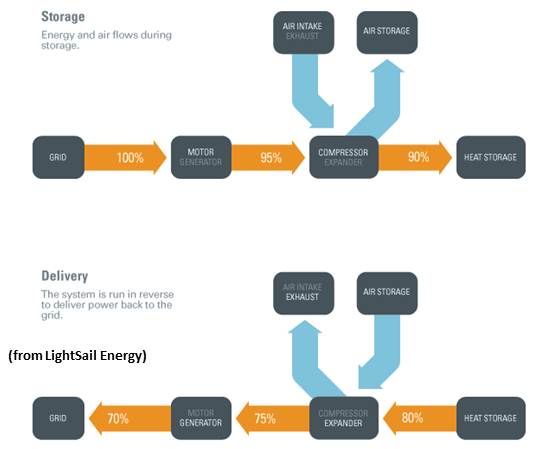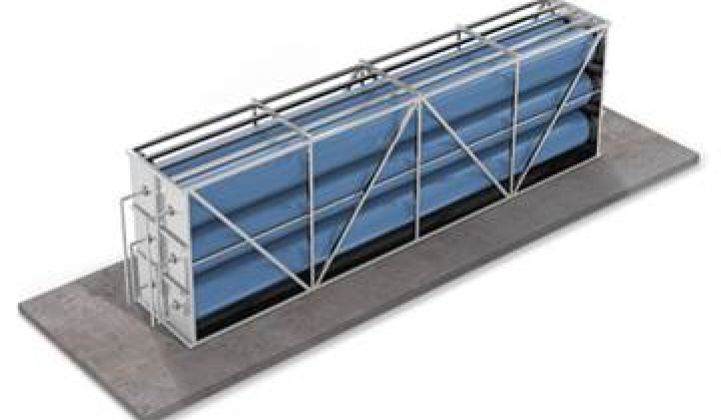LightSail Energy, a grid-scale energy storage startup, just added $5.5 million to its coffers. New investor Total, the French Energy giant, joined Peter Thiel, Bill Gates, Khosla Ventures, and Innovacorp in the second closing of its $37.3 million Round D.
François Badoual, CEO of Total Energy Ventures, said in a release, “Energy storage is an important enabler for the long-term development of alternative energies and to ensure the stability of electricity supply." Total is also a major investor in SunPower (NASDAQ:SPWR).
It's still early days for energy storage and for LightSail, of which CEO Steve Crane says, "We've mostly had our heads down trying to productize our technology."
LightSail's funding announcement arrives after last week's energy storage ruling from the California Public Utility Commission (CPUC). The CPUC is asking Southern California Edison to procure 50 megawatts of energy storage over the next eight years, according to a final decision issued Wednesday. It's among the first state regulatory rulings that put grid storage at center stage.
Here's some of our recent coverage of LightSail:
In the words of Steve Crane, CEO and co-founder of the firm, "LightSail Energy is applying thermodynamics (the science of heat transfer and utilization) to solve the problems of today’s electrical grid. The lack of economical energy storage at megawatt-scale has limited the penetration of renewable energy generation, such as wind and solar, in many parts of the world. LightSail’s technology makes power available when it’s needed, not just when it’s available."
Peter Thiel, an early investor in Facebook, has been less than enthusiastic about investing in cleantech, but LightSail looks to have changed his mind. Thiel writes in a release, “For far too long, the cleantech industry has been driven by politicians and ideologues who trade people’s taxes for dreams,” said Peter Thiel. “But hype is not a sustainable energy source. While authentic energy breakthroughs are needed to overcome geological constraints, fraudulent companies have driven out the good. It’s time to find honest companies that can develop technologies that stand on real innovation instead of the backs of taxpayers. LightSail is run by engineers, not salespeople, and it promises to be one of the first true alternative energy storage companies.”
The goal for LightSail, Crane said, is to provide grid-scale storage “as cost-effectively and efficiently as pumped hydro, but without the geographic restrictions.”

According to Crane, “multiple studies” from the Electric Power Research Institute, DOE labs and the EIA all show that “for large-scale applications, compressed air energy storage is going to be cheaper” than any alternative other than pumped hydro.
The reason is simple, he explained: Air is “the cheapest thing there is.”
Compressed air can match pumped hydro’s “price point,” Crane said, “but not the efficiency.” Batteries can match “the efficiency, but not the price point.”
To make CAES more efficient, Crane explained, the LightSail system captures and stores both the mechanical energy and the thermal energy used in compressing air. To do this, a water mist is infused into the compression chamber as the air is compressed. Water can hold 3,300 times as much heat as the same volume of air, and as such, it is able to capture the heat generated by the process more effectively. Both potential energy in the form of pressurized air and the heated (and therefore higher-energy) water can be stored.
When the captured, pressurized air is released back through the system, the heated water is re-infused into it. That heated air can return more of the energy stored by the system than can other CAES processes.

Crane explained that LightSail’s technology uses two basic components: the compressor unit and the storage tanks.
The firm presently uses a prototype high-speed compressor adapted from an off-the-shelf oil field pipeline gas compressor “about the size of a room,” Crane said. Under controlled conditions, it has shown the potential “of delivering about 100 kilowatts of power.” Crane continued: “At 3,000 psi,” a kilowatt-hour requires a tank “of about 50 liters.”
The company has worked through many generations of spray nozzles and spray-nozzle arrays to better infuse the mist, capture the heat of compression rapidly and efficiently, and return that thermal energy.
“By holding on to the heat,” Crane said, “you can take the system from 60 percent thermal efficiency to 90 percent thermal efficiency.” That can make CAES more economically efficient than older generations of the technology, which can lose a huge amount of energy -- perhaps as much as 80 percent -- in heat.
The LightSail team is working on the system’s round-trip efficiency, he said, but they have “consistently achieved over 90 percent thermodynamic efficiency.” This means, he explained, that 90 percent of the power used to drive the compressor’s piston now ends up stored.
The company will not ship its first product until 2013. “Somewhere between half a megawatt to a megawatt is the sweet spot,” Crane said of the planned initial capability. Over the course of several years, Crane expects to ramp up the total storage capability, though the logistics of very large-scale storage “are well beyond what we’re capable of now.”
An April 2011 Sandia Labs cost estimate, according to Crane, put the “present-worth cost of ten-year operation in year one” of a CAES system with 4 hours to 8 hours of storage capacity at $1,470 per kilowatt. The study also found that batteries are $2,000 per kilowatt and up at that scale. “They all conclude that compressed air energy storage is the cheapest type of large-scale storage,” Crane said, “with the possible exception of pumped hydro.”
For short-duration, fifteen-minute to one-hour electricity storage, Crane's advice is to “buy a lithium-ion battery. It’s probably more cost-effective.”
At four hours and up, however, the benefits of CAES “become more and more obvious” because “it’s easy to add capacity. You just add more storage tanks. The air is free.” And, he added, “the containers to store compressed air are cheap compared to adding storage capacity to any other technology.”
The one problem with CAES, Crane admitted, is efficiency. “That’s the bet. If we can keep the price advantage while solving the round-trip efficiency [issue], we have an unbeatable approach.”
Other startup innovators in CAES include General Compression, SustainX, and Bright Energy.



